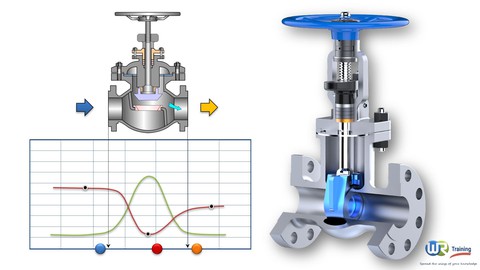
Sizing valves and control valves for the process industry
Sizing valves and control valves for the process industry, available at $64.99, has an average rating of 4.38, with 38 lectures, 3 quizzes, based on 155 reviews, and has 1064 subscribers.
You will learn about Be more innovative in your solutions to valve and control valve problems Have an organized approach to the procedure of valve sizing in accordance with the ANSI & ISA recommendations Be able to size valves for any flow conditions likely to be found in a process plant Have a general notion about the confidence to be placed in the sizing result conclusions Download our valuable Valve Sizing Excel Spreadsheet This course is ideal for individuals who are Chemical, Process, Petroleum Engineers or Design Engineers or Piping Engineers or Plant Engineers or Recent College Graduates It is particularly useful for Chemical, Process, Petroleum Engineers or Design Engineers or Piping Engineers or Plant Engineers or Recent College Graduates.
Enroll now: Sizing valves and control valves for the process industry
Summary
Title: Sizing valves and control valves for the process industry
Price: $64.99
Average Rating: 4.38
Number of Lectures: 38
Number of Quizzes: 3
Number of Published Lectures: 38
Number of Published Quizzes: 3
Number of Curriculum Items: 41
Number of Published Curriculum Objects: 41
Original Price: €44.99
Quality Status: approved
Status: Live
What You Will Learn
- Be more innovative in your solutions to valve and control valve problems
- Have an organized approach to the procedure of valve sizing in accordance with the ANSI & ISA recommendations
- Be able to size valves for any flow conditions likely to be found in a process plant
- Have a general notion about the confidence to be placed in the sizing result conclusions
- Download our valuable Valve Sizing Excel Spreadsheet
Who Should Attend
- Chemical, Process, Petroleum Engineers
- Design Engineers
- Piping Engineers
- Plant Engineers
- Recent College Graduates
Target Audiences
- Chemical, Process, Petroleum Engineers
- Design Engineers
- Piping Engineers
- Plant Engineers
- Recent College Graduates
June 24 course update:
We have added quizzes to help you test your knowledge and emphasize the key learning points. The quiz includes:
-
True/False questions
-
Multi-choice questions
-
Images, cross-sectionnal views
-
Solved problems
-
and much more…
When you think you’ve got a good grasp on a topic within the course, you can test your knowledge by taking the quiz. If you pass, wonderful ! If not, you can review the videos and notes again or ask us for help in the Q&A section.
—
Designed around a series of practical examples which we work through to a solution, this valuable online course is an essential guide to understanding the valve sizing procedure. This understanding is a prerequisite for a successful operation of your plant and piping system.
In this course, we will present a step-by-step sizing methodology. We will show you how to proceed in the sizing of a valve in the daily practice, how to determine the flow coefficient (Cv) when selecting a control valve size, how to predict the maximum flow rate that a selected valve will pass or how to determine the pressure differential that a selected valve will exhibit, just to name a few…
You will learn from our industrial experience what we wrongly calculatedduring project startup, debottlenecking and commissioning. This should undoubtedly help you minimize the mistakes in the sizing and selection of your valves.
Included in this course is access to a valuable Valve Sizing Excel Spreadsheet. This tool will help you perform all the calculations that we will discuss further ahead in the course. It has all the sizing equations, numerical constants and other parameters built right in.
The Valve Sizing Excel Spreadsheet provides well organized technical data in form of spreadsheet calculations indispensible for anyone involved in the sizing of valves. It presents formulae and data for :
-
Valve flow coefficients Cv
-
Flow of fluids through valves
-
Pressure drop through valves and attached fittings
-
Valve Reynolds Number calculations
-
Predicting maximum flow through valves in choked conditions
-
Representative values of valve capacity factors
-
And much more…
The spreadsheet includes two worksheets :
-
Sizing for liquids (incompressible fluids)
-
Non vaporizing flow conditions
-
Choked flow conditions
-
-
Sizing for vapors and gases (compressible fluids)
So as you can see here, detailed technical descriptions and basic step-by-step instructions will be provided to you along with practice sessions, quizzes, a valuable Valve Sizing Spreadsheet and numerous downloadable resources, to emphasize the key learning points.
So with no further ado, check out the free preview videos and the curriculum of the course and we look forward to seeing you in the first section.
WR Training
Spread the wings of your knowledge
—
IMPORTANT NOTES : VALVE SIZING SPREADSHEET
-
We assume that Microsoft Excel is installed on your computer and that you have basic knowledge of using Excel
-
This Valve Sizing Excel Spreadsheet includes Visual Basic for Application function subroutines (VBA). Macros must be enabled for them to work
DISCLAIMER
The Valve Sizing Excel Spreadsheet is provided by WR Training “as is” and any express or implied warranties, including, but not limited to, the implied warranties of merchantability and fitness for a particular purpose are disclaimed. In no event shall the Copyright owner or contributors be liable for any direct, indirect, incidental, special, exemplary, or consequential damages (including, but not limited to, procurement of substitute goods or services, loss of use, data, or profits, or business interruption) however caused and on any theory of liability, whether in contract, strict liability, or tort (including negligence or otherwise) arising in any way out of the use of this spreadsheet, even if advised of the possibility of such damage.
Course Curriculum
Chapter 1: About the course
Lecture 1: Introduction
Lecture 2: Before to start this course
Lecture 3: Valve Sizing Spreadsheet
Chapter 2: Preliminaries
Lecture 1: Scope
Lecture 2: Introduction
Lecture 3: Useful terminology
Lecture 4: Pressure, Velocity and Energy profiles through valves
Lecture 5: Cavitation, Choked Flow and Flashing
Lecture 6: Before proceeding to the next section
Chapter 3: Incompressible fluids
Lecture 1: Non vaporizing liquids
Lecture 2: Sizing equations for turbulent flow
Lecture 3: Piping geometry factor Fp
Lecture 4: EXAMPLE #1 : Sizing a valve for liquid propane
Lecture 5: Sizing equations for non turbulent flow
Lecture 6: More insights on non turbulent flow
Lecture 7: Determining the required flow coefficient Cv
Lecture 8: EXAMPLE #2 : Sizing a valve for a laminar flow
Lecture 9: Predicting flow rate through valves
Lecture 10: EXAMPLE #3 : Predicting flow rate through a valve for transient flow
Lecture 11: Predicting pressure drop through valves
Lecture 12: EXAMPLE #4 : Predicting pressure drop for laminar flow
Lecture 13: Choked flow of vaporizing liquids
Lecture 14: Liquid critical pressure ratio factor FF
Lecture 15: Liquid pressure recovery factor FL (without fittings)
Lecture 16: Combined liquid pressure recovery factor FLP (with fittings)
Lecture 17: EXAMPLE #5 : Predicting maximum flow through a valve
Lecture 18: Before proceeding to the next section
Chapter 4: Compressible fluids
Lecture 1: Turbulent flow
Lecture 2: Expansion factor
Lecture 3: Choked flow
Lecture 4: Pressure drop ratio factor (without fittings)
Lecture 5: Pressure drop ratio factor (with fittings)
Lecture 6: Ratio of specific heats factor
Lecture 7: Compressibility factor
Lecture 8: EXAMPLE #6 : Determining valve size and percent opening
Lecture 9: Before proceeding to the next section
Chapter 5: Downloadable resources
Lecture 1: Included in this course
Lecture 2: Bonus
Instructors
-
WR Training
Petroleum Petrochemical & Chemical Engineering
Rating Distribution
- 1 stars: 0 votes
- 2 stars: 2 votes
- 3 stars: 13 votes
- 4 stars: 62 votes
- 5 stars: 78 votes
Frequently Asked Questions
How long do I have access to the course materials?
You can view and review the lecture materials indefinitely, like an on-demand channel.
Can I take my courses with me wherever I go?
Definitely! If you have an internet connection, courses on Udemy are available on any device at any time. If you don’t have an internet connection, some instructors also let their students download course lectures. That’s up to the instructor though, so make sure you get on their good side!
You may also like
- Best Video Editing Courses to Learn in February 2025
- Best Music Production Courses to Learn in February 2025
- Best Animation Courses to Learn in February 2025
- Best Digital Illustration Courses to Learn in February 2025
- Best Renewable Energy Courses to Learn in February 2025
- Best Sustainable Living Courses to Learn in February 2025
- Best Ethical AI Courses to Learn in February 2025
- Best Cybersecurity Fundamentals Courses to Learn in February 2025
- Best Smart Home Technology Courses to Learn in February 2025
- Best Holistic Health Courses to Learn in February 2025
- Best Nutrition And Diet Planning Courses to Learn in February 2025
- Best Yoga Instruction Courses to Learn in February 2025
- Best Stress Management Courses to Learn in February 2025
- Best Mindfulness Meditation Courses to Learn in February 2025
- Best Life Coaching Courses to Learn in February 2025
- Best Career Development Courses to Learn in February 2025
- Best Relationship Building Courses to Learn in February 2025
- Best Parenting Skills Courses to Learn in February 2025
- Best Home Improvement Courses to Learn in February 2025
- Best Gardening Courses to Learn in February 2025






















